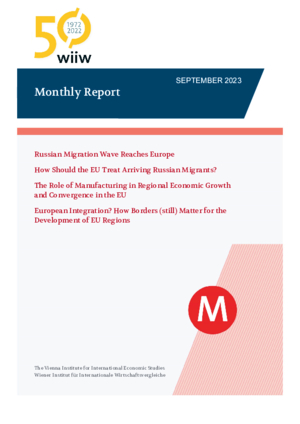Monthly Report No. 9/2023
Vasily Astrov, Vladislav L. Inozemtsev, Ambre Maucorps and Roman Römisch
wiiw Monthly Report No. 9, September 2023
53 pages including 30 Figures
- Chart of the Month: Russian migration wave reaches Europe
by Vasily Astrov
- Opinion Corner: How should the EU treat arriving Russian migrants?
by Vladislav Inozemtsev
Since the start of the war in Ukraine, no fewer than 1 million people have left Russia – arguably the biggest wave of ethnic Russian emigration since the 1920s. European governments should treat this as an opportunity and should welcome most Russian migrants by offering them residence and work permits. Russians may constitute the most affluent and prosperous European diaspora, and that could benefit the host economies.
- The role of manufacturing in regional economic growth and convergence in the EU
by Roman Römisch
This article focuses on the role of the manufacturing sector in regional economic development in the EU. Its findings indicate that the development of the manufacturing sector has positive growth effects, independent of a region’s degree of urbanisation. This suggests that policies focused on industrialisation could foster regional growth and the convergence of less-developed regions. However, there are many obstacles to such policies.
- European integration? How borders (still) matter for the development of EU regions
by Ambre Maucorps
The ambition of the EU to become ‘an ever closer union among the peoples of Europe’ has been the main rationale for its far-reaching policy action towards economic, social and territorial cohesion. Yet EU border regions lag behind their so-called inner peers economically and socially, pointing up the persistent negative impact of country borders on regional growth, despite European integration efforts. Whereas in Western Europe this gap has generally been narrowing, in most of EU-CEE it is continuing to widen, sometimes significantly. This has important implications not only for the cross-border consolidation of the EU single market, but also for the EU enlargement process.
- Monthly and quarterly statistics for Central, East and Southeast Europe
Reference to wiiw databases: wiiw Annual Database, wiiw Monthly Database
Keywords: Russian migration, first residence permits, remittances, labour market integration, political migrants, regional economic growth, convergence, manufacturing, mean logarithmic deviation index, border regions, inner regions, regional convergence
Countries covered: CESEE, EU, Russia
Research Areas: Labour, Migration and Income Distribution, Regional Development
